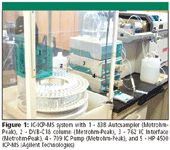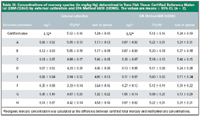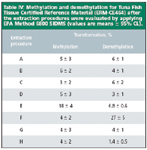Evaluation of Extraction Methods and Bias Correction by EPA Method 6800 Protocol for Mercury Species in Tuna Fish Tissue Using an Ion Chromatograph Coupled to an ICP–MS
The Application Notebook
Mercury pollution mainly originates from industrial activities such as chlorine production, garbage incineration and above all coal-fueled power generation. The US Environmental Protection Agency (US EPA) considers mercury as highly toxic with a pronounced accumulative and persistent character.
Mercury pollution mainly originates from industrial activities such as chlorine production, garbage incineration and above all coal-fueled power generation. The US Environmental Protection Agency (US EPA) considers mercury as highly toxic with a pronounced accumulative and persistent character.
Currently, environmental mercury is commonly measured and reported as elemental mercury. However, once released into the environment, mercury undergoes various transformations. Thus mercury is found in several forms, particularly as elemental, inorganic or alkylated mercury with a pronounced transformation from inorganic mercury to the biologically active methylmercury and vice versa. Likewise, the extraction techniques used for separation and preconcentration tend to alter the original distribution of the different mercury species, which seriously complicates the elucidation of the original distribution of mercury species and legal defensibility of the data.
This paper evaluates several extraction techniques that are used for mercury speciation in biological samples by applying external calibration analysis and speciated isotope dilution mass spectrometry (SIDMS). The SIDMS technique utilized is the recently published EPA RCRA Method 6800, which provides the ability to monitor mercury isotopes in each species and quantify transformations between mercury species. EPA Method 6800 permits species biases corrections in the extractions under investigation.
Introduction
One of the groups that have specialized in the analysis and measurements of mercury species in biological samples is that of Professor Skip Kingston and his coworkers who use ion chromatography (IC) coupled to inductively coupled plasma mass spectrometry (ICP–MS). The Kingston research group has developed a technique called speciated isotope dilution mass spectrometry (SIDMS) for speciation analysis. Often, species can undergo interconversion from one form to another during sample collection and sample preparation. An example of an element that can potentially be involved in this type of conversion is chromium. Depending upon the pH and the redox potential, chromium can interconvert bidirectionally between Cr3+ and Cr6+ (1). By introducing enriched isotopic species spikes into the analytical process, which is the main feature of the SIDMS protocol, one can correct for and measure interconversions to derive true concentrations of the species. US EPA Method 6800 (2) is based on this technique.
The most common forms or species of mercury found in the environment are elemental mercury (Hg0 ), inorganic mercury compounds (Hg2+ ) and biologically active organic mercury (methylmercury CH3Hg+ ). Methylmercury is considered the most toxic species and is classified as a neurotoxin that rapidly bioaccumulates and can cause major health problems or death, even in very small quantities (3). According to the US FDA, the major exposure pathway to methylmercury in humans and wildlife is through the consumption of contaminated fish. The US EPA has calculated a reference dose for methylmercury (Rf) of 0.1 μg/kg of body weight per day, while the World Health Organization (WHO) has set a tolerable dose of 1.6 μg/kg of body weight per week (4).
Experimental
SIDMS has been automated using IC coupled to ICP–MS in the Kingston Laboratory to measure mercury species in environmental (5, 6) and biological matrices (7). Major problems in solid matrices result from the lack of a reliable analytical method to extract mercury species without affecting species stability. The group recently completed work evaluating different analytical sample preparation methods commonly used to extract mercury species from biological samples. The reference material used for the comparison of sample preparation methods was Tuna Fish Tissue Certified Reference Material (ERM-CE464) supplied by IRMM (Geel, Belgium), which is certified for total mercury and methylmercury content. The evaluated extraction methods were based on literature-referenced methods such as alkaline extraction with potassium hydroxide (KOH) or tetramethyl ammonium hydroxide (TMAH) solution; acid leaching with hydrochloric acid (HCl), nitric acid (HNO3), or glacial acetic acid (CH3COOH); extraction with L-cysteine hydrochloride, and enzymatic digestion with protease XIV. The methods are summarized in Table I (8).

Table I: Summary of the sample preparation methods evaluated
Sample separation was automated using Metrohm IC modules (Metrohm-Peak, Houston, Texas) coupled to an ICP–MS model HP 4500 (Agilent Technologies, Palo Alto, California and Yokogawa Analytical System Inc., Tokyo, Japan). The coupling of the IC system to ICP–MS is shown in Figure 1. The conditions used during the study are detailed in Table II.

Figure 1
As an alternative to external calibration, Hg2+ and CH3Hg+ compounds were quantified by EPA 6800 protocol specifications spiking the sample before the extraction with 199 Hg2+ and CH3200 Hg+ and application of SIDMS equations (2). The isotopic species reagents and calculation software in a SPC-M™ Mercury Speciation Kit was provided by Applied Isotope Technologies (AIT, Sunnyvale, California). This double-spike approach allowed tracking of any artifact stemming from methylation/demethylation reactions that might have occurred during the sample preparation and/or analysis procedure.

Table II: Instrumental operation conditions for ICâICPâMS system
Results and discussion
Figure 2 (8) shows the chromatogram for the separation of the divalent mercury ion from methylmercury. Table III gives the results for quantification of the mercury species by both external calibration and specific isotope dilution.

Figure 2
The accuracy of the method was tested by both external calibration analysis and SIDMS using the Tuna Fish Tissue Certified Reference Material (ERM-CE464). The results demonstrate that speciated isotope dilution analysis is a powerful method that facilitates analysis of the mercury species with high precision, accuracy and correction of species transformations.

Table III: Concentrations of mercury species (in mg/kg Hg) determined in Tuna Fish Tissue Certified Reference Material (ERM-CE464) by external calibration and EPA Method 6800 (SIDMS). The values are means ± 95% CL (n = 3).
Based upon the data shown in Tables III and IV, the concentrations found for methylmercury in the alkaline extraction procedures using either ultrasonic-assisted system (procedures A and B) or microwave device (procedure C) were in good agreement at the 95% confidence level with the certified values. These procedures yielded equivalent methylation and demethylation (approx. 6%). However, the required extraction time was significantly reduced using the microwave extraction procedure (C in Table I). Although similar results were obtained with procedure G, inorganic mercury contamination in the extracting reagent was observed. Extraction with 5 mol/L HCl (procedure D) or enzymatic digestion with protease (procedure H) showed quantitative results of methylmercury with lower transformation of methylmercury to inorganic mercury (3 and 1.4%, respectively). Despite frequent use of acid leaching for the extraction of mercury species from tuna fish samples, the lowest concentration of methylmercury on the ERM-CE464 and the highest mercury species transformation occurred when microwave assisted extraction with 4 mol/L HNO3 (procedure E) or glacial acetic acid (procedure F) was used.

Table IV: Methylation and demethylation for Tuna Fish Tissue Certified Reference Material (ERM-CE464) after the extraction procedures were evaluated by applying EPA Method 6800 SIDMS (values are means ± 95% CL).
Conclusions
This work illustrates the unprecedented advantage that Method 6800 (SIDMS) offers for studying the transformations of mercury species during sample preparation in fish tissue samples in order to improve precision and accuracy of the final results. Because of the unique features and benefits of the EPA Method 6800, it is expected that utilization of SIDMS will increase and that this indispensable tool for optimizing and validating trace-metals speciated sample preparation procedures, involving extraction, separation, and detection, will gain much wider popularity by analytical chemists.
Acknowledgments
We thank Milestone Inc. for the financial support to Laura H. Reyes and for instrumental support. We also thank Agilent Technologies, Applied Isotope Technologies, Inc., Duquesne University and Metrohm-Peak, for instrumental and material support.

References
(1) Rahman GMM, Kingston HM, Towns TG, Vitale RJ, Clay KR, "Determination of hexavalent chromium by using speciated isotope-dilution mass spectrometry after microwave speciated extraction of environmental and other solid materials," Anal. Bioanal. Chem. 2005, 382, 1111–20.
(2) US EPA Method 6800, "Elemental and speciated isotope-dilution mass spectrometry, tests methods for evaluating solid waste, physical/chemical methods SW 846," Update IVA. US Government Printing Office (GPO), 2007, Washington, DC.
(3) Gochfeld M, "Cases of mercury exposure, bioavailability and absorption," Ecotoxicol. Environ. Saf., 2003, 56, 174–9.
(4) Levenson CW, Axelrad DM, "Too much of a good thing? Update on fish consumption and mercury exposure," Nutr. Rev. 2006, 64, 139–45.
(5) Rahman GMM, Kingston HM, "Application of speciated isotope dilution mass spectrometry to evaluate extraction methods for determining mercury speciation in soils and sediments," Anal. Chem. 2004, 76, 3548–55.
(6) Rahman GMM, Kingston HM, "Development of a microwave-assisted extraction method and isotopic validation of mercury species in soils and sediments," J. Anal. Atomic. Spectrom., 2005, 20, 183–91.
(7) Rahman GMM, Fahrenholz T, Kingston HM, "Simultaneous mercury species transformation correction during analysis in human tissue by applying speciated isotope dilution mass spectrometry with validation using a certified reference material," manuscript in preparation.
(8) Reyes, L.; Rahman, GMM, Fahrenholz T, Kingston, HM, "Comparison of methods with respect to efficiencies, recoveries and quantitation of mercury species interconversions in food demonstrated using tuna fish," Anal. Bioanal. Chem., 2008, 390, 2123–32.

High pH and Temperature with HALO® ELEVATE C18, 1.5 mm ID Column
December 11th 2024Over the course of 5000 injections, the HALO®Elevate C18 1.5 mm ID column demonstrates stability and robustness in the stationary phase and the column hardware, with no significant changes to the retention time, peak shape, and back pressure.














